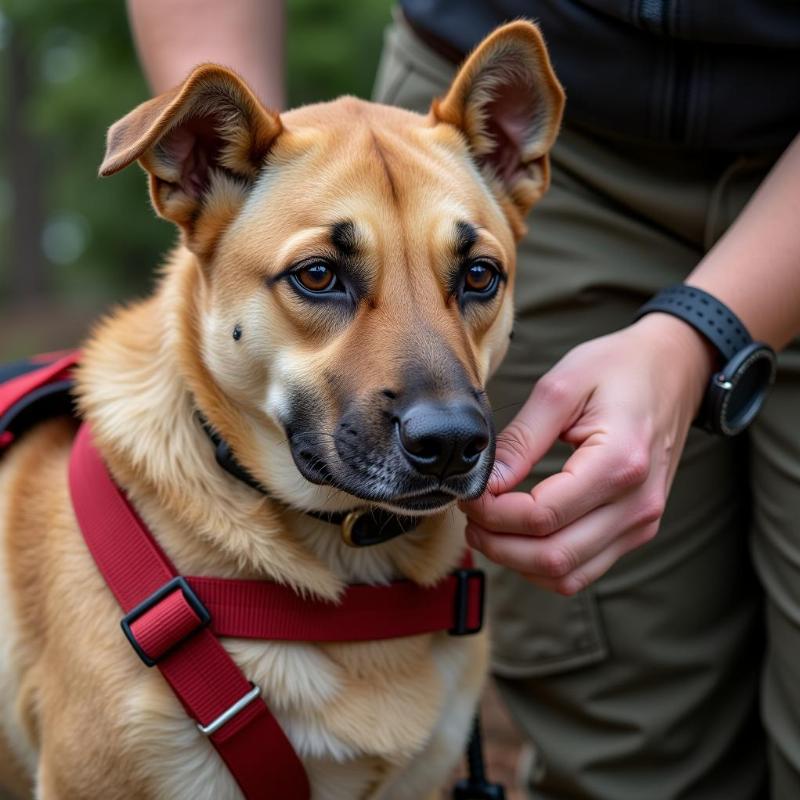A search and rescue (SAR) dog’s harness is more than just a piece of equipment; it’s a vital tool that ensures their safety and effectiveness in the field. Choosing the right search and rescue dog harness is a crucial decision for any handler, impacting the dog’s comfort, mobility, and ability to perform demanding tasks. This guide provides comprehensive information on selecting the perfect search and rescue dog harness for your canine partner in the United States.
Choosing the correct harness for your SAR dog involves considering a variety of factors, from the terrain they’ll be navigating to the specific tasks they’ll perform. A poorly fitted or inadequate harness can hinder their movement, cause discomfort, or even lead to injury. Therefore, understanding the nuances of search and rescue dog harnesses is paramount for any handler.
Key Features of a Search and Rescue Dog Harness
A robust and reliable harness is essential for SAR dogs. Look for harnesses constructed from durable, weather-resistant materials like nylon or Cordura. Reinforced stitching and heavy-duty hardware are also crucial for withstanding the rigors of SAR operations. The harness should fit snugly but allow for a full range of motion, and adjustable straps are essential for achieving a perfect fit.
Furthermore, a well-designed SAR harness will include features like multiple attachment points for ropes and other gear, a sturdy handle for lifting and assisting the dog, and reflective strips for visibility in low-light conditions.
Different Types of Search and Rescue Dog Harnesses
Various types of harnesses cater to the diverse needs of SAR operations. The most common types include:
- Vest Harnesses: These offer excellent coverage and distribute weight evenly, making them suitable for dogs carrying packs or navigating challenging terrain.
- Tracking Harnesses: Designed for tracking and trailing work, these harnesses often feature a single back attachment point to prevent interference with the dog’s natural movement.
- Rappelling Harnesses: Specialized harnesses built for technical rope work, ensuring the dog’s safety during vertical rescues.
Choosing the right type depends on your dog’s specific role within the SAR team and the typical environments they work in.
Fitting and Adjusting Your Search and Rescue Dog Harness
Proper fit is paramount for a SAR dog’s comfort and safety. The harness should fit snugly without restricting movement or chafing. Ensure you can fit two fingers between the harness and the dog’s body. Adjustable straps allow you to customize the fit, and it’s essential to check the fit regularly, especially as your dog grows or changes weight.
Maintaining Your Search and Rescue Dog Harness
Regular maintenance extends the life of your SAR harness and ensures its continued reliability. Clean the harness after each use, removing dirt, debris, and any potential contaminants. Inspect the harness for signs of wear and tear, such as frayed stitching or damaged hardware. Replace the harness immediately if you find any damage.
 Cleaning and Inspecting SAR Dog Harness
Cleaning and Inspecting SAR Dog Harness
Choosing the Right Harness for Your SAR Dog: Expert Advice
“A properly fitted harness can significantly enhance a SAR dog’s performance and safety,” says Dr. Emily Carter, DVM, a veterinary specialist with extensive experience working with SAR teams. “It’s crucial to consider the dog’s individual needs, the type of work they’ll be doing, and the terrain they’ll be navigating.”
Another expert, certified dog trainer and SAR handler, John Miller, adds, “Investing in a high-quality harness is an investment in your dog’s well-being and the success of your SAR missions. Don’t compromise on quality when it comes to your canine partner’s safety.”
Conclusion
Selecting the appropriate search and rescue dog harness is a critical decision that impacts your dog’s safety, comfort, and performance in the field. By understanding the key features, different types, and proper fitting techniques, you can equip your canine partner with the best possible gear for their vital role. A well-chosen search and rescue dog harness will contribute significantly to the success of your SAR missions.
FAQ
-
How often should I replace my dog’s SAR harness? Replace the harness as soon as you notice any signs of wear and tear or at least annually.
-
What material is best for a SAR harness? Durable, weather-resistant materials like nylon or Cordura are ideal.
-
Can I use a regular dog harness for SAR work? No, SAR harnesses are specifically designed for the demands of search and rescue operations.
-
How do I know if the harness fits my dog correctly? You should be able to fit two fingers between the harness and your dog’s body.
-
Where can I purchase a search and rescue dog harness? Specialty pet supply stores and online retailers specializing in SAR equipment.
Beautdogs.us is your premier online resource for all things dog-related in the United States. We offer expert advice on dog breeds, care, and product recommendations, catering to both novice and experienced dog owners. From finding the perfect dogs for adoption in concord nc to learning how to train a blood trailing dog, we’ve got you covered. Beautdogs.us is committed to providing you with reliable information and helping you build a stronger bond with your furry friend. Contact us at [email protected] or call us at +1 501-555-7529. Visit Beautdogs.us today!